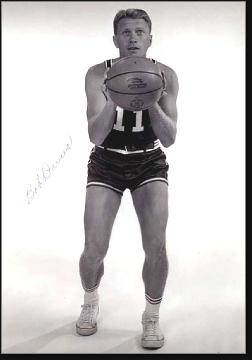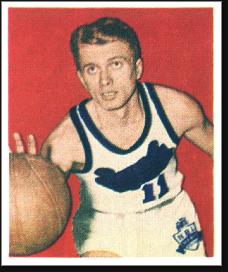
Sport: Basketball
Born: January 15, 1920
Died: April 22, 1990
Town: South Orange, New Jersey
Robert Edris Davies was born January 15, 1920 in Harrisburg, PA. A gifted all-around athlete as a boy, Bob was nicknamed “Jack Armstrong” after the popular radio character of the 1930s. Bob loved how the city’s African-American basketball players pushed the ball down the court to create 2-on-1s and 3-on-2s. However, this style did not impress the coach at John Harris High, so Bob often found himself riding the pine for the Pioneers
Bob was known primarily as a baseball shortstop in his hometown, and was recruited to play on the diamond at Seton Hall, where he hit .321 for the Pirates during his college career. He went out for the basketball team and, after one practice, coach Honey Russell convinced him to focus his athletic skills on hoops.
Bob was a revelation. A fantastic ball-handler and shooter, he was one of the first college players who could create his own shot every time he touched the ball. The Pirates were a perfect 19–0 in Bob’s sophomore season in 1939–40, albeit it against relatively weak opponents.
In 1940–41, the Pirates (aka “Wonder Five”) were one of the top teams in the nation. They ran their unbeaten streak to 43 games but lost to LIU in the National Invitation Tournament that spring. During the NIT, Bob unveiled a move he’d perfected in practice: the behind-the-back dribble. Bob could drive on a defender and switch directions in stride without exposing the ball with a cross-over dribble. Time and again he blew past defenders, and overnight he had a new nickname: “The Harrisburg Houdini.”
The LIU players trash-talked and physically intimidated Bob when they played Seton Hall. Bob ignored them and played superbly. After games (the Pirates lost both times the schools met), Bob smiled and shook hands with his Blackbird tormentors. LIU coach Clair Bee was so impressed that he later modeled his fictional sports hero, Chip Hilton, after Bob.
Bob was an All-American in 1941 and again in 1942. He decided to forgo his senior baseball season and joined the Navy during World War II. He trained at the Great Lakes Naval Station, where many pro athletes served as Phys Ed instructors. Bob starred for the Great Lakes basketball team, which included fellow stars Dick Triptow and Seymour Smith.
Unlike most well-known athletes, Bob saw action during the war as an officer on a mine sweeper. His boat was one of the first in the invasion of southern France in 1944 and later he commanded a mine sweeper in the Pacific. While on leave, Bob suited up for the Brooklyn and New York clubs in the American Basketball League.

Bob signed with the Rochester Royals of the National Basketball League near the end of the 1945-46 season and helped the Royals win the NBL championship. He caught a lot of his pro teammates by surprise with his quick moves and no-look passes, but did not use the behind-the-back dribble. Team owner Les Harrison warned him that this might be considered showboating, and would probably invite hard fouling. Many feel that Bob ushered the transition game into pro basketball.
Bob’s second pro season was his most impressive. Not only did he lead the Royals to back-to-back titles, he was named NBL MVP and also found time to coach Seton Hall to a 24–3 record. His undersized lineup in South Orange was dubbed the “Mighty Midgets.”
After Rochester joined the NBA, Bob was named first-team All-NBA three times before retiring in 1955. In 1950–51, the Royals won the NBA championship behind Bob and a constellation of stars that included Jack Coleman, Red Holzman, Bobby Wanzer, Arnie Risen and Pep Saul. Wanzer and Saul had played for Bob at Seton Hall. In 1954-55, at age 35, he set an NBA record with 20 assists in a game.
After basketball, Bob coached at Gettysburg College before going to work as a salesman for Converse. In 1964, Bob’s younger brother, Dick, who starred for LSU in the late 1950s, won a gold medal in the Tokyo Olympics. Bob had coached Dick at Gettysburg before he transferred to LSU. In 1970, Bob was inducted into the Basketball Hall of Fame. He passed away at the age of 70 in Hilton Head, South Carolina.